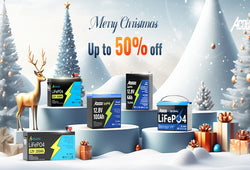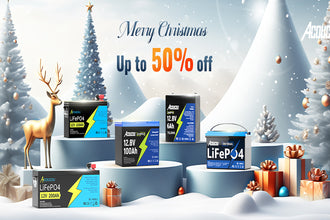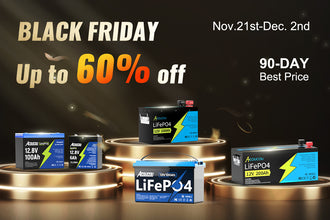

When it comes to choosing a campervan battery, there are several important factors to consider to ensure that you have a reliable power source for your adventures on the road. A good campervan battery is crucial for powering your lights, appliances, and electronic devices while you're off the grid.
What Is Campervan Battery?
Like RV batteries, there are two types of campervan batteries: starter battery and house battery.
Starter Battery
- Starting the vehicle:The engine of an RV usually uses a battery as the starting power source. The battery provides starting current to start the engine and enable the RV to operate normally.
House Battery
- Power supply: Campervans are usually equipped with batteries to provide power supply, especially when there is no external power supply. Acoucou batteries can provide electricity for the appliances inside the campervan(such as lamps, refrigerators, televisions, air conditioning, etc.), to maintain indoor lighting, temperature control, and other power needs.
- Emergency backup power supply: Acoucou batteries can also serve as an emergency backup power supply for campervans. When we can not connect to external power sources or external power sources have some problems, batteries can provide power for critical equipment, such as emergency communication equipment, lighting, and electronic systems, to ensure safety and functions can operate in emergencies. In order to deal with emergencies and outages, many people build an off-grid system with Acoucou batteries.
- Solar energy storage: Some campervans are also equipped with solar panels that convert sunlight into electrical energy to charge the campervan battery. This solar system can provide independent power for campervans for a longer time, reducing dependence on truck engines and fuel consumption. Acoucou can be charged with solar and store the solar power to operate appliances. Meanwhile, it also can be charged by charger and generator.
What Should We Consider When Choosing A Campervan Battery?
Durability and lifespan
Look for a campervan battery that is durable and able to withstand the rigors of life on the road. Consider the battery's lifespan and warranty to ensure that you are making a long-term investment.
Capacity
The capacity of a battery is measured in amp-hours (Ah) and indicates how much energy the battery can store. Consider the power requirements of your campervan appliances and devices to determine the right capacity for your battery.
Size and weight
The size and weight of the battery will affect where and how you can install it in your campervan. Make sure to choose a battery that fits in your designated space and is not too heavy for your vehicle.
Our lithium battery is only 1/3 of the weight of a lead-acid battery, easy to move and install.
Voltage
Campervan batteries typically come in 12V or 24V configurations. Make sure to choose a battery that is compatible with your campervan's electrical system.
Cycling ability
If you plan on using your campervan battery for frequent deep discharges and recharges, consider a deep-cycle battery designed for this purpose.
DOD is the percentage of battery discharge to battery-rated capacity. Over 80%DOD is deep-cycle battery. SOC is the ratio of the remaining capacity of a battery after being used for a period of time or left unused for a long time to its fully charged capacity.
Acoucou LiFePO4 batteries have 12000+ cycles and 100% SOC&DOD to utilize the power for long term.
Charging options
Consider how you plan to charge your campervan battery, whether through solar panels, a generator, or a vehicle alternator. Make sure the battery you choose is compatible with your charging setup.

Safety
There is no doubt that the safety of battery and people are both the most important. LiFePO4 batteries are the safest battery type available today. Acoucou LiFePO4 battery has a built-in Battery Management System(BMS): overcharging and discharging protection, overcurrent and short circuit protection, low-temperature charging cut-off, high-temperature charging or discharging cut-off, overvoltage and undervoltage protection.

Different Types Of Batteries for Campervan
2 common batteries are used in campervan: lead-acid battery and LiFePO4 battery.
Lead-acid batteries
It is the cheapest and most widely used in the market. Compared to other batteries, it has a lower energy density and is heavier. It has a shorter life and fewer cycles usually 200-500 times. It is generally not recommended to discharge lead-acid batteries below 50% of the battery capacity.
- Flooded lead-acid batteries (FLA)
Flooded lead-acid batteries, also known as deep-cycle or wet-cell batteries. If properly maintained, the service life of FLA can reach 8 years. These batteries use a liquid electrolyte solution and are constructed with lead plates submerged in sulfuric acid. FLA batteries are known for their affordability, but they require regular maintenance, including checking and adding distilled water to the cells to ensure proper electrolyte levels.
- Sealed Lead-Acid Batteries (SLA)
Sealed lead-acid batteries, also referred to as valve-regulated lead-acid (VRLA) batteries, offer a maintenance-free alternative to FLA batteries. SLA batteries come in two variations: Absorbent Glass Mat (AGM) and Gel batteries.
- AGM Batteries
Its average lifespan of 4 to 6 years. AGM batteries use a fiberglass mat soaked in electrolyte as a separator between the lead plates. This design enables the electrolyte to be absorbed and immobilized, making AGM batteries spill-proof and vibration-resistant. AGM batteries are generally more expensive than FLA batteries but provide better reliability and longer service life.
- Gel Batteries
Its average lifespan of 5 to 7 years. Gel batteries feature a thickened electrolyte in a gel form that is immobilized between the lead plates. This gel electrolyte provides improved resistance to vibration, deep cycling capability, and extended lifespan. Gel batteries are highly durable, maintenance-free, and can handle high-demand applications. However, they tend to be more expensive than both FLA and AGM batteries.
LiFePO4 batteries

- Long service life: The lifespan of LiFePO4 battery is usually several times that of lead-acid battery. It can generally last for 7 to 10 years of use. Acoucou LiFePO4 battery has 12000+ cycles and a 10-year life.
- Safety: LiFePO4 batteries are the safest battery type available today. BMS can protect the battery better and make it last longer. Acoucou LiFePO4 battery has a built-in BMS that people can check the situation of batteries through Bluetooth in the APP.
- Maintenance-free: Unlike lead-acid batteries, LiFePO4 batteries do not require regular water replenishment.
- Fast charging: Acoucou 12V 100Ah LiFePO4 battery can be fully charged in 5 hours with a charger. Lead-acid battery usually needs to be charged for 6 to 8 hours.
- Small and light: LiFePO4 batteries have higher energy density and are much lighter than lead-acid batteries. Acoucou LiFePO4 12V 100Ah is 29.98 lbs nearly 1/3 of the weight of the same type of lead-acid battery.










